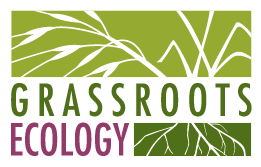Invasive Plant of the Month: Yellow Starthistle
Yellow starthistle (Centaurea solstitialis) is in the knapweed genus Centaurea, the same genus as cornflower, aka bachelor’s button (C. cyanus). This genus belongs to the sunflower family, Asteraceae. This herbaceous yet rigid plant is a long-lived annual. Blue-green winged leaves attach to its stem, and it has thistle-like yellow flowers with spines around the base of the flowerhead.
Ecology and Invasiveness
Yellow starthistle is native to the Mediterranean basin. It's often considered a weed within its native range too, although seen more as a minor inconvenience rather than the bane of their existence. It thrives on disturbed soil, with dry conditions and high light exposure. At higher elevations, it prefers south facing slopes. It is very well adapted to living with the cool, wet winters and hot, dry summers of a Mediterranean climate, like we have here in California.
Yellow starthistle can inhibit the growth of other plants, forming dense stands.
Yellow starthistle is very damaging outside of its native range, with a tendency to form monocultures that crowd out native plants and pose a physical barrier for animal passage. It is early to establish, its deep taproot greatly depleting soil moisture. This allows it to outcompete shallow rooted annuals in times of limited soil moisture, and last into the summer much longer than other annuals. Aside from tremendous water use, it provides food or habitat for very few native species.
It is also known to cause a neurological condition in horses when it makes up a large enough portion of the horse's diet. This condition, called nigropallidal encephalomalacia, or “chewing disease”, causes Parkinson’s-like symptoms. Once symptoms develop, horses can no longer eat and die of starvation. Despite the disastrous consequences, horses sometimes develop a taste for it, and actively seek it out.
The plant is also allelopathic, meaning it emits chemicals into the soil that inhibit the growth of other plants. Its chemical weapons are more effective in its non-native range than in its native range.
Since being introduced, yellow starthistle has become highly invasive in the western US, especially in California. It is estimated that it infests over 15 million acres of land in California. It is invasive in many other parts of the world as well, including southern South America, southern Africa, and southern Australia. It is thought to have been accidentally introduced to California in the 1850s around Sacramento, with contaminated fodder seed from Chile (where it is also introduced) when ranching picked up in California after the gold rush. The seed continues to be spread by vehicles, transportation of livestock, and contaminated seed or soil.
One plant can produce up to 75,000 seeds, and new seeds germinate with every rain. Most of the seed bank lasts in the soil for about 3 years, with a small percentage lasting quite a bit longer.
Managing Yellow Starthistle
Across yellow starthistle’s non-native range, restoration ecologists have found success with many methods of removal, including hand pulling, herbicide application, mowing, burning, and grazing (by sheep, goats, cattle). Alongside these methods, biocontrols—the use of an organism’s natural predators as pest control—have been introduced (so far, 2 weevil and 2 fly species have been approved for use and are established in California). These insects lay eggs in the flowerheads, and the hatched larvae eat the seeds upon emergence. A rust fungus that reduces growth and destroys leaves has also been introduced.
Grassroots Ecology manages yellow starthistle at Pearson-Arastradero Preserve, Byrne Preserve, O’Keefe Preserve, the Hawthorns area of Windy Hill Preserve, Foothills Nature Preserve, Russian Ridge Open Space Preserve, and Stulsaft Park. However, it is observable in many places, including roadsides, hiking trails, vacant lots, pastures, parks, and preserves.
At Grassroots Ecology, we manage it through strategically timed mowing followed by hand removal of re-sprouts with volunteers. The ideal time to mow is determined by annual visual inspection of the phenology of the plants. The first mow usually falls near the summer solstice, after plants have bolted (sent up their flowering head) and lost their basal leaves, but before seeds have matured and dispersed. This ensures that much of the plant’s energy has been spent on bolting, and its photosynthetic capabilities have diminished, making resprouting much less likely.
After density is reduced by multiple seasons of mowing, we hand pull the remaining plants before they go to seed. Using these methods, Grassroots Ecology has observed an estimated 85.6% reduction in average density of yellow starthistle at the Hawthorns Area of Windy Hill Preserve after just 2 years of management.
When yellow starthistle is flowering, we bag it and dispose of it off-site.
Cultural Uses
Although a costly nuisance where it is invasive, this plant is commonly utilized for honey production in these areas. It is heavily utilized by honey bees, and yields protein rich, high quality honey. However, this likely contributes to the spread and resilience of the species, as pollination promotes outcrossing (aka cross pollination), which makes for more genetically diverse, and therefore resilient, populations.
Interestingly, it is not usually used within its native range for honey, but has a plethora of other uses*, especially medicinally. It has traditionally been used to treat respiratory and digestive ailments, viral infections, protozoan diseases (like malaria), lesions, eye conditions, and kidney stones. In Italy, Iran, Saudi Arabia, and Turkey, it is used as food, in soups, pastries, boiled, etc. Clinically, it has been proven to be an antioxidant, effective treatment of stomach ulcers, antibacterial for staph, accelerate healing of herpes lesions, reduces perception of painful stimuli, and reduces fever. Some compounds found in the plant also demonstrate anticancer activity! Besides medicinal uses, it is also used as fodder for sheep, being dried and used as a winter food source. In Turkey, the dried stems and branches are used to make brooms.
*Note: Do not eat or utilize wild plants unless you have confidently identified the species, harvested according to relevant laws/permissions, and prepared them according to the proper protocols.
How You Can Help
Yellow starthistle typically bolts and flowers in June or July. If you find it at home, we recommend pulling by hand after it bolts but before it flowers; place piles of this sun-loving weed in the shade to prevent resprouting. Also, consider replacing it with native grassland plants to reduce germination in the following year, enhance biodiversity, and improve ecosystem resilience.
In summer, our Youth Stewards and Naturalist Interns play important roles in removing and monitoring yellow starthistle. You can join us at a volunteer event this summer to help manage yellow starthistle and other weeds.
By Natalie Jagoda, California Climate Action Corps Member




